
Morocco 1999
Page 1
| I took a bus from Casablanca to Essaouira (pronounced Ess-weera) . Along this six-hour bus ride that hugged the Atlantic coast, I met a couple of very friendly guys, one from France and one from Casablanca, who were going to stay with their family in Essaouira. They invited me to spend time with them and come over and eat homemade tagine, a ceramic dish in which vegetables, meat, olives, oil, and spices are slow-cooked with a conical (not "comical"!) top to seal in the delicious flavor. I also encountered a Moroccan prostitute, who quickly exited the bus after I said, "La, la" ("No, no."). My first bus ride in Morocco had begun in a rather fascinating manner! |
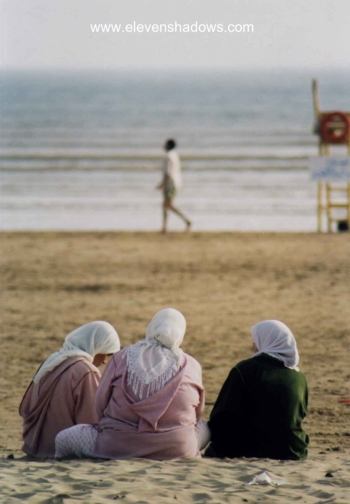 Essaouira is a town of contrasts. There are not very many
places in the Arabic world where you can see fully veiled women sitting on the beach while
others windsurf and frolic in bikinis. The wind here can sometimes be a little
obnoxious for those trying to simply relax on the beach, but otherwise, the beaches are
quite pleasant, and the whole town has a very open, airy feel to it, even within the
imposing walls. Essaouira is a town of contrasts. There are not very many
places in the Arabic world where you can see fully veiled women sitting on the beach while
others windsurf and frolic in bikinis. The wind here can sometimes be a little
obnoxious for those trying to simply relax on the beach, but otherwise, the beaches are
quite pleasant, and the whole town has a very open, airy feel to it, even within the
imposing walls.Essaouira is the windsurfing capital of Morocco. The town itself is also quite charming, and much of the city is contained within fortress walls built by the Portuguese, French, and Berber for military use. Inside the walls are pleasant cafes, shops, cobblestone streets, and artisan's shops. After having Air France lose my luggage for almost three days, you can understand why heading south to Essaouira sounded very appealing! |
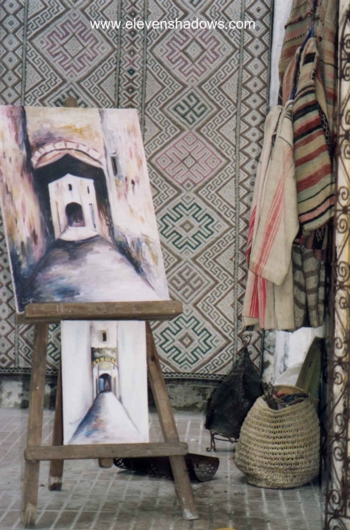 Essaouira is known for its artists, and craftsman can frequently be seen toiling away in their shops. Essaouira also has had a history of attracting artists. Orson Welle's "Othello" was filmed here, with the opening scene showing the ramparts. Jimi Hendrix, Jefferson Airplane, and Leonard Cohen all hung out here. Nowadays, Essaouira is also known for its growing tourism, sardine fishing, and prosperous agriculture in the surrounding areas. |
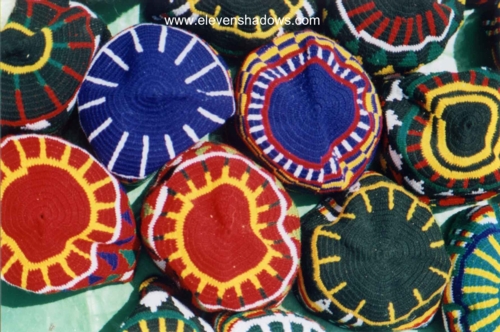 Essaouira. Essaouira.I ended up staying in Essaouira for about two weeks, hanging out with people in Hotel Tafraout and with the very lovely family who lived just outside the walled portion of the city who were related to the two guys on the bus. We spent a lot of the time going out to eat, eating in their home, playing basketball, swimming, going to the beach, and simply hanging out. |
 I spent a lot of time with this very lovely family while in
Essaouira. As a very special treat, Hind (right) and her aunt prepared some
mouth-watering couscous. Homemade couscous is so much more delicious than its
restaurant counterpart that it almost tastes like a different dish altogether! The
dish is placed in the middle of the table, and then everyone basically digs in. The
traditional method of eating couscous is to roll it in your hands, which is far more
difficult than it looks. All of us except for Hind's aunt used spoons. This
family's incredibly warm hospitality was one of the highlights of the trip for me. I spent a lot of time with this very lovely family while in
Essaouira. As a very special treat, Hind (right) and her aunt prepared some
mouth-watering couscous. Homemade couscous is so much more delicious than its
restaurant counterpart that it almost tastes like a different dish altogether! The
dish is placed in the middle of the table, and then everyone basically digs in. The
traditional method of eating couscous is to roll it in your hands, which is far more
difficult than it looks. All of us except for Hind's aunt used spoons. This
family's incredibly warm hospitality was one of the highlights of the trip for me. |
|
Berber Monty Python? A few of us at the hotel frequented Le Petit Perle, perhaps my favorite restaurant in Morocco. Hind and I went there twice for dinner as well, so I was there quite a bit. The restaurant had Berber musicians who played there in the evening. The traditional method of playing this particular type of energetic mountain music (Moroccan Roll?) is accompanied with a sort of stuttery hopping motion accompanied with a constant thrusting up of one of the shoulders. While eating and observing this kinetic hopping motion, I leaned over to Lil, one of the English girls at our hotel, and mentioned that it looked like the king in Monty Python who pretends to ride his imaginary horse while someone behind him clomps coconut shells rhythmically to simulate hoofbeats. After this, every time this poor Berber musician did this shoulder/hopping motion, try as we might to stop, we would double over, howling with laughter! We ended up befriending the Berber musicians, fortunately. Shouts of "zween bizzaf" and "ishwa" ("very beautiful" in Arabic and Berber) resulted in big toothy grins from the musicians. |
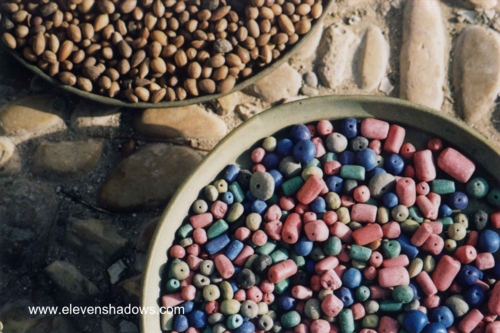 Beads and things, Essaouira. Beads and things, Essaouira. |
| Happy Birthday North African Style
There was a very silent Moroccan boy who had been hanging out in the street all day and
all night. Lil was very concerned about him, as he hadn't eaten all day. This
day, July 15th, also happened to be Lil's 18th birthday. We ended up taking the
Moroccan kid for a stroll along the beach, and then took him to Le Petit Perle for tagine.
Meanwhile, I told the waiter that it was Lil's birthday. He in turn told the
Monty Python-esque Berber musicians, who sang a Berber version of "Happy
Birthday" with all the patrons looking on. One of the Berber musicians handed
Lil a very pretty wooden box with carved designs on it as a birthday gift.
Meanwhile, I slipped out and ran around the corner to the local patisserie to purchase a
chocolate cake, and then ran back to the restaurant. Producing the birthday cake, I
was joined by the waiters as they and anyone else in the restaurant who could manage to
croak or hum the words to "Happy Birthday" (The English Version) attempted to
sing. We then divided the cake up and passed it around to the Berber musicians and
the waiters, while the Moroccan boy gleefully doled out portions to the befuddled but
happy restaurant guests. All of the restaurant guests and us bonded over the
chocolate cake, and we spent the rest of the evening, past closing time, discussing the
merits of chocolate and other internationally appreciated cuisine in broken French and
broken English. We stumbled out of there late, with the kid suddenly recovering from
his amnesia and remembering his way home, and Lil shaking her head, saying that this was
the craziest but most fun birthday she ever had. |
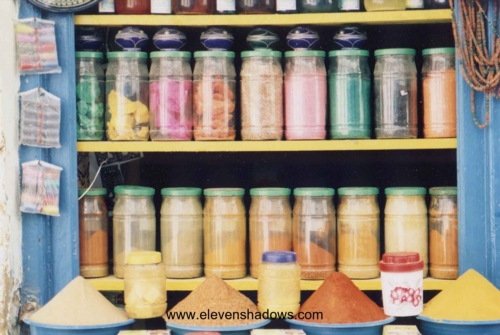 Spices and soaps, Essaouira. Spices and soaps, Essaouira. |
 Beneath the ramparts of the Skala de la Ville in Essaouira are
quite a few workshops specializing in exquisite woodwork, made from the local thuya
tree. Beneath the ramparts of the Skala de la Ville in Essaouira are
quite a few workshops specializing in exquisite woodwork, made from the local thuya
tree. Rue de Skala, along the ramparts, one could watch the local artisans craft these lovely tabletops and avoid the sometimes pushy storekeepers. Walking up to the ramparts, I was rewarded with gorgeous views of the coast and part of the walled medina below. |
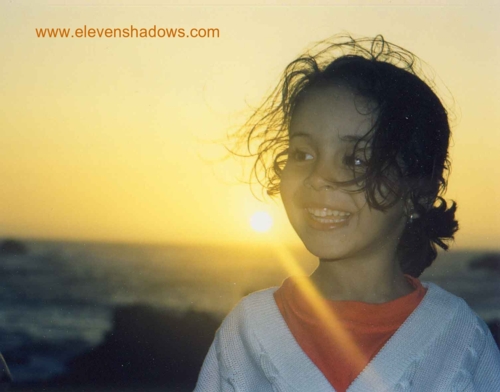 Place Prince Moulay Hassan in Essaouira,
located in between the harbor and the walled city, is a very pleasant place
to hang out and watch the sun go down. Here, one can enjoy incredibly
fresh fish and the salty sea air while watching the sun melt into the
Atlantic. Place Prince Moulay Hassan in Essaouira,
located in between the harbor and the walled city, is a very pleasant place
to hang out and watch the sun go down. Here, one can enjoy incredibly
fresh fish and the salty sea air while watching the sun melt into the
Atlantic.This photo has been used for Captive Daughters pamphlets and on their web site in the past. |
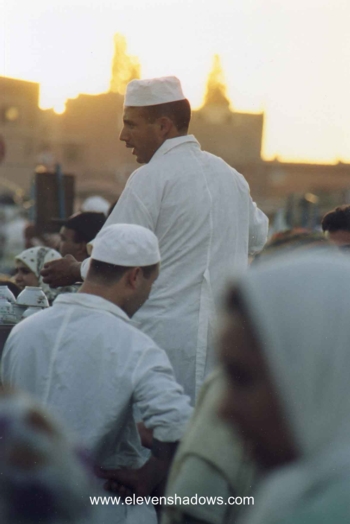 Marrakesh. Marrakesh.After almost two weeks in beautiful Essaouira, I took a three-hour bus ride inland to Marrakesh, set in a valley below the High Atlas Mountains. For me, much of the appeal of going to Marrakesh was to see Djemaa Al-Fna square. Here, every evening, one of the most fascinating spectacles unfolds, as storytellers, jugglers, Berber acrobats and musicians, henna artisans, herbalists, and complete lunatics arrive at the square, swamped by spectators trying to get a peek at the activities. One can even get their tooth pulled here! Surrounding this spectacle, food vendors set up shop, serving everything from escargot, such as the gentleman in this picture is doing, to couscous, tagines, sandwiches, salads, and even sheep's heads. |
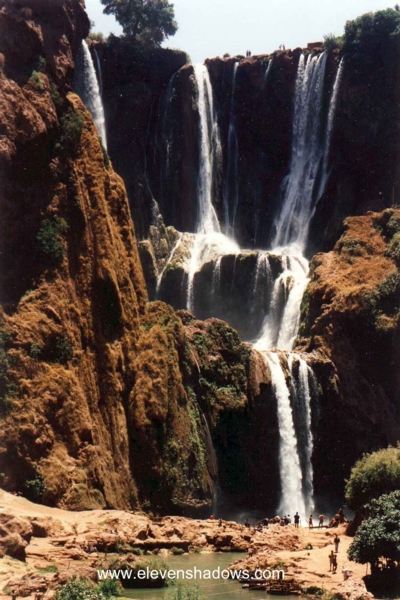 The very lovely Cascades D'Ouzoud, or Waterfall of the Olives.
These are located about 167km northeast of Marrakesh in the High Atlas Mountains.
Day trips can be arranged from Marrakesh very easily, or it can make a great
stopover point on your way north from Marrakesh, as there are plenty of camping areas
available for only 10 dirhams (about US$1). I chose to see the waterfalls as a day
trip, returning to Marrakesh later in the evening. The very lovely Cascades D'Ouzoud, or Waterfall of the Olives.
These are located about 167km northeast of Marrakesh in the High Atlas Mountains.
Day trips can be arranged from Marrakesh very easily, or it can make a great
stopover point on your way north from Marrakesh, as there are plenty of camping areas
available for only 10 dirhams (about US$1). I chose to see the waterfalls as a day
trip, returning to Marrakesh later in the evening. This is the prettiest waterfall I have ever seen.
|
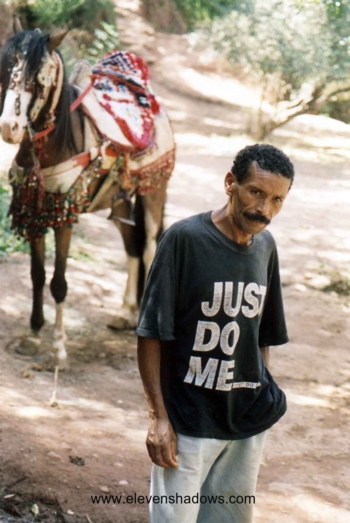 Just
do me. Just
do me. |
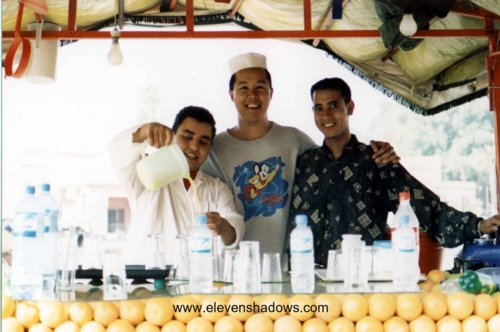 In the wild Djemaa Al-Fna, there are at least
fifty orange juice stalls that surround the square. All of them sell freshly
squeezed orange juice. Not anything else. If you love freshly squeezed orange
juice, you'll think you're in heaven. A cup is only 2 dirham (US$.20). I kept
going back to Juice Stall #23, and after a while, we became very friendly, and the vendor
(left side) would frequently top off my glass. I even got a chance to sell orange
juice at #23, shouting "Jus d'orange, deux dirham!" at passing tourists! In the wild Djemaa Al-Fna, there are at least
fifty orange juice stalls that surround the square. All of them sell freshly
squeezed orange juice. Not anything else. If you love freshly squeezed orange
juice, you'll think you're in heaven. A cup is only 2 dirham (US$.20). I kept
going back to Juice Stall #23, and after a while, we became very friendly, and the vendor
(left side) would frequently top off my glass. I even got a chance to sell orange
juice at #23, shouting "Jus d'orange, deux dirham!" at passing tourists! |
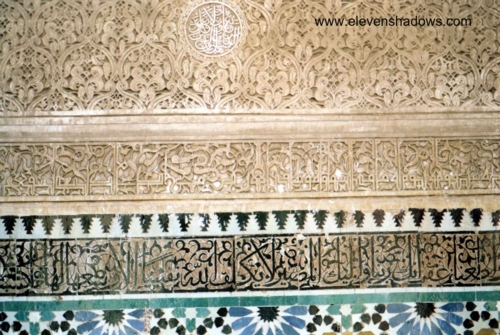 A close-up of one of the walls in the charming Palais de la
Bahia in Marrakesh, which was built around the end of the 19th century. A close-up of one of the walls in the charming Palais de la
Bahia in Marrakesh, which was built around the end of the 19th century.
The above is plaster mixed with marble powder, and is carved with designs and quotes from the Q'uran. Below that are tile inlays. |
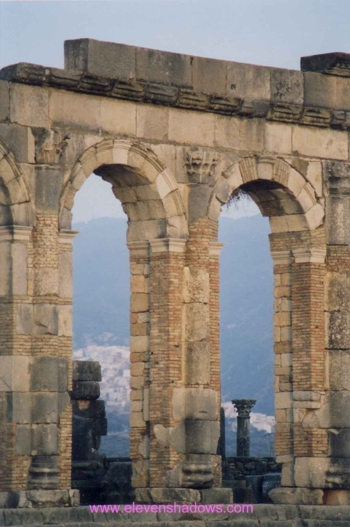 After taking an overnight train north to Meknes,
using the "train-as-hotel" method of traveling, I arrived in the imperial city
of Meknes very early in the morning. I secured a hotel near the old medina, and then
immediately met up with some women from England who were leaving shortly via grand taxi to
the Roman ruins of Volubilis. This was a destination that I very much wanted to see,
so despite not getting very much sleep, I went with them to see these magnificent ruins,
perched atop a hill that is surrounded by bountiful orchards and valleys of olive groves. After taking an overnight train north to Meknes,
using the "train-as-hotel" method of traveling, I arrived in the imperial city
of Meknes very early in the morning. I secured a hotel near the old medina, and then
immediately met up with some women from England who were leaving shortly via grand taxi to
the Roman ruins of Volubilis. This was a destination that I very much wanted to see,
so despite not getting very much sleep, I went with them to see these magnificent ruins,
perched atop a hill that is surrounded by bountiful orchards and valleys of olive groves.Volubilis was one of the Roman Empire's most remote outposts, aside from the outpost at Lixus (5 km from the charming town of Larache on the Atlantic Coast). Volubilis became part of the Roman Empire around 40 A.D., and most of the more impressive monuments, such as the Basilica shown here, were built in the 2nd and 3rd Centuries. The Basilica served as the law courts and the trading center. |
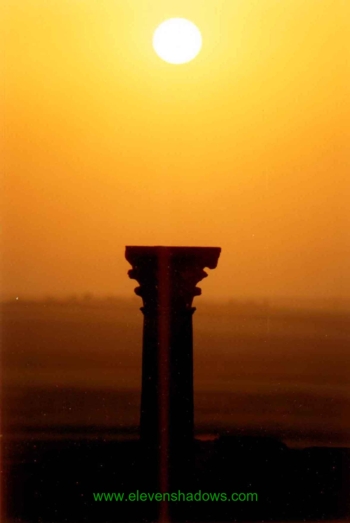 House of the Columns in Volubilis. House of the Columns in Volubilis.
Volubilis continues to be excavated by a team of Moroccan and French archeologists. We also visited the nearby town of Moulay Idriss, which is perched up on lovely mountains only several kilometers from Volubilis. For Moroccans, Moulay Idriss has been a place of pilgrimmage, and has only been open to non-Muslims for the since the 1930s. |
Morocco 1999
Page 1
Morocco and Spain Home Page
Eleven Shadows Travel Page
Contact photographer/musician Ken Lee